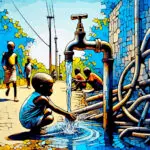-
Table of Contents
“Namibia’s Tap Water: A Testament to Sustainability Amidst Scarcity.”
Introduction

Namibia, located in southwestern Africa, is a country characterized by its arid and semi-arid climate, making water scarcity a significant issue. The tap water in urban areas of Namibia is generally safe to drink and meets the World Health Organization standards. However, in rural areas, access to clean and safe tap water can be limited, with many relying on boreholes or natural sources which may not be treated adequately. The quality of tap water can vary greatly depending on the location within the country.
Understanding the Quality of Tap Water in Namibia
Namibia, a country located in southwestern Africa, is known for its diverse wildlife and stunning landscapes. However, one aspect that often goes unnoticed is the quality of its tap water. Understanding the quality of tap water in Namibia is crucial, not only for the residents but also for the tourists who visit this beautiful country.
Namibia is a semi-arid country, and water scarcity is a significant issue. The country relies heavily on underground water sources and desalination plants for its water supply. The tap water in urban areas, such as Windhoek, the capital city, is generally safe to drink. It is treated and purified to meet the World Health Organization’s standards for drinking water. The process involves removing impurities and harmful bacteria, ensuring that the water is safe for consumption.
However, the situation is different in rural areas. The tap water in these regions may not be as safe due to inadequate water treatment facilities. The water sources in these areas are often contaminated with harmful bacteria and parasites, making the water unsafe for drinking. Therefore, it is advisable for individuals in these areas to boil the water before consumption or use bottled water.
The quality of tap water in Namibia also varies depending on the season. During the rainy season, the risk of water contamination increases due to runoff from agricultural lands and urban areas. This runoff can carry harmful substances such as pesticides and industrial waste into the water sources. Therefore, during this period, it is recommended to take extra precautions when consuming tap water.
The Namibian government has been making efforts to improve the quality of tap water in the country. They have invested in water treatment facilities and infrastructure to ensure that clean and safe drinking water is available to all residents. The government has also launched awareness campaigns to educate the public about the importance of safe drinking water and the steps they can take to ensure their water is safe for consumption.
Despite these efforts, challenges remain. The country’s arid climate and limited water resources make it difficult to provide safe drinking water to all residents, especially those in remote and rural areas. Furthermore, the increasing demand for water due to population growth and urbanization is putting pressure on the existing water resources.
In conclusion, the quality of tap water in Namibia varies depending on the location and the season. While the tap water in urban areas is generally safe to drink, caution should be exercised in rural areas and during the rainy season. The Namibian government is making efforts to improve the situation, but challenges remain due to the country’s arid climate and limited water resources. Therefore, it is advisable for individuals, especially tourists, to stay informed about the water situation in the area they are visiting and take necessary precautions to ensure their health and safety.
The Impact of Drought on Namibia’s Tap Water Supply
Namibia, a country located in the southwestern part of Africa, is renowned for its stunning landscapes and rich biodiversity. However, beneath this beauty lies a pressing issue that has been plaguing the nation for years – water scarcity. This problem is particularly evident in the quality and availability of tap water, which is significantly impacted by the recurrent droughts that the country experiences.
Namibia is predominantly arid or semi-arid, with an average rainfall that is less than half of the global average. This climatic condition, coupled with high evaporation rates, makes the country highly susceptible to droughts. These droughts have a profound impact on the country’s tap water supply, as they reduce the amount of surface water available for treatment and distribution.
The country’s water supply is heavily reliant on surface water sources such as rivers and dams. However, these sources are highly vulnerable to drought conditions. When droughts occur, the water levels in these sources drop significantly, leading to a decrease in the amount of water that can be treated and supplied to the population. This results in water rationing, where the supply of tap water is limited to certain hours of the day, or even certain days of the week.
Furthermore, the quality of the tap water is also affected by droughts. As the water levels in rivers and dams decrease, the concentration of pollutants in the water increases. This is because the same amount of pollutants is now spread over a smaller volume of water, leading to a higher concentration of pollutants. Consequently, the water requires more treatment before it is safe for consumption. However, the treatment process is expensive and time-consuming, and the country’s water treatment facilities often struggle to keep up with the demand during drought periods.
In addition to surface water, Namibia also relies on groundwater for its water supply. However, the impact of droughts on groundwater is more insidious. While the water levels in groundwater sources do not drop as quickly as those in surface water sources, they recharge at a much slower rate. This means that even after a drought has ended, it can take years for the groundwater levels to recover. This slow recovery rate, combined with the increasing demand for water due to population growth and economic development, puts a significant strain on the country’s groundwater resources.
In response to these challenges, the Namibian government has implemented several measures to improve the country’s water security. These include the construction of desalination plants, the promotion of water-saving practices, and the exploration of alternative water sources such as reclaimed water. However, these measures are not without their challenges, and the country continues to grapple with the issue of water scarcity.
In conclusion, the tap water supply in Namibia is significantly impacted by the recurrent droughts that the country experiences. These droughts reduce the availability of surface water, affect the quality of the water, and put a strain on the country’s groundwater resources. While efforts are being made to address these issues, water scarcity remains a pressing concern in Namibia.
Exploring the Safety Measures for Tap Water in Namibia
Namibia, a country located in the southwestern part of Africa, is known for its diverse wildlife and stunning landscapes. However, one aspect that often raises questions among visitors and residents alike is the quality and safety of its tap water. This article aims to shed light on the safety measures for tap water in Namibia, providing an informative and comprehensive overview of the subject.
Namibia is a country that experiences arid conditions for most of the year, making water a precious resource. The government, recognizing the importance of water, has implemented stringent measures to ensure the safety and quality of tap water. The Ministry of Agriculture, Water, and Forestry is primarily responsible for the management and regulation of water resources in the country. This includes the provision of safe drinking water to the public.
The tap water in Namibia undergoes a rigorous purification process before it reaches the taps of households. The process begins with the collection of water from various sources such as rivers, boreholes, and dams. This water is then treated at water treatment plants where it undergoes several stages of purification. These stages include coagulation, sedimentation, filtration, and disinfection. Each stage is designed to remove different types of contaminants, ensuring that the water is safe for consumption.
The water treatment plants in Namibia are equipped with modern technology and are operated by highly trained professionals. They conduct regular tests on the water to ensure that it meets the standards set by the World Health Organization (WHO). These tests check for various parameters such as pH, turbidity, and the presence of harmful bacteria and chemicals. If any of these parameters are found to be outside the acceptable range, the water is treated again until it meets the required standards.
Despite these measures, it is important to note that the quality of tap water can vary across different regions of Namibia. In urban areas, where the infrastructure is more developed, the tap water is generally safe to drink. However, in rural areas, the quality of tap water can be inconsistent due to factors such as inadequate infrastructure and lack of access to water treatment facilities. In such cases, it is recommended to boil the water before consumption or use bottled water.
Furthermore, the government of Namibia is continuously working on improving the water infrastructure in the country. Several projects are underway to expand the water supply network and upgrade the existing water treatment facilities. These efforts are aimed at ensuring that every citizen has access to safe and clean drinking water.
In conclusion, the tap water in Namibia is generally safe to drink, thanks to the rigorous purification process it undergoes and the stringent measures implemented by the government. However, the quality can vary across different regions, and it is advisable to take precautions when in rural areas. As a visitor or resident, it is always a good idea to stay informed about the local water conditions and take necessary precautions to ensure your health and safety.
The Role of Desalination in Providing Tap Water in Namibia
Namibia, a country located in the southwestern part of Africa, is predominantly arid, with the Namib Desert stretching along its entire Atlantic coastline. This geographical feature, coupled with the country’s low annual rainfall, makes water scarcity a significant challenge. The scarcity of freshwater resources has necessitated the exploration of alternative water sources, with desalination emerging as a viable solution. This article will delve into the role of desalination in providing tap water in Namibia.
Desalination is a process that removes salts and other minerals from saline water, making it suitable for human consumption and irrigation. In Namibia, the desalination process has been instrumental in addressing the water shortage problem, particularly in coastal areas. The country’s first large-scale desalination plant, located in the Erongo region, was commissioned in 2010. This plant, which uses reverse osmosis technology, has the capacity to produce 20 million cubic meters of potable water annually, significantly contributing to the country’s water supply.
The desalinated water from this plant is primarily used to meet the water demands of the uranium mining industry, which is a significant contributor to Namibia’s economy. However, a portion of this water is also channeled to the municipal water supply system, thereby augmenting the tap water supply in the towns of Swakopmund and Walvis Bay. The quality of this desalinated tap water is closely monitored and adheres to the World Health Organization’s guidelines for drinking water quality, ensuring it is safe for human consumption.
The success of the Erongo desalination plant has spurred interest in expanding desalination efforts across the country. The Namibian government, in collaboration with various stakeholders, is exploring the feasibility of constructing additional desalination plants. These proposed plants aim to increase the availability of tap water in other regions of the country, particularly in Windhoek, the capital city, which has been grappling with water shortages due to population growth and climate change.
However, while desalination offers a promising solution to Namibia’s water scarcity problem, it is not without challenges. The process is energy-intensive, which raises concerns about its environmental impact and sustainability. Moreover, the high cost of desalination makes it a less affordable option for a developing country like Namibia. To address these challenges, the government and its partners are investing in research and development to improve the efficiency of desalination technology and reduce its environmental footprint.
In conclusion, desalination plays a crucial role in providing tap water in Namibia, particularly in the coastal regions. The technology has proven to be a reliable alternative water source in the face of the country’s persistent water scarcity problem. However, for desalination to be a sustainable solution, it is imperative to address the associated environmental and economic challenges. As such, the Namibian government’s efforts to expand and improve desalination technology are a step in the right direction towards ensuring a reliable supply of tap water for its citizens.
Q&A
1. Question: Is tap water safe to drink in Namibia?
Answer: In most urban areas of Namibia, tap water is generally safe to drink. However, in rural areas, it’s recommended to drink bottled water due to potential contamination.
2. Question: What is the quality of tap water in Namibia?
Answer: The quality of tap water in Namibia varies. In urban areas, it is usually of good quality, but in rural areas, it can be of lower quality due to lack of proper sanitation and filtration systems.
3. Question: Are there any common issues with tap water in Namibia?
Answer: Common issues with tap water in Namibia include occasional water shortages due to drought and potential contamination in rural areas.
4. Question: How is the taste of tap water in Namibia?
Answer: The taste of tap water in Namibia can vary depending on the location. In urban areas, it is generally tasteless, while in rural areas, it may have a different taste due to the minerals present in the water.
Conclusion
The tap water in Namibia is generally safe to drink in urban areas, but the quality can vary in rural regions. However, due to occasional water shortages and contamination risks, it is often recommended for travelers to drink bottled water.






